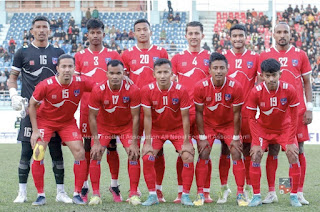SAFF Championship needs to be competitive and meaningful
The participation of Kuwait and Lebanon in the upcoming 14th edition of the South Asian Federation Football Championship in Bengaluru,India from June 21 to July 3 is welcome news.
The decision made by the South Asian Federation Football(SAFF) Championship committee to invite the two countries to the tournament is laudable and a step in the right direction.
It is first and foremost important for Kuwait and Lebanon to take the SAFF Championship seriously and send their first national teams.
Only then can their presence become meaningful and relevant and pave the way for the tournament to become competitive, compelling, exciting and interesting.
The SAFF Championship,the premier regional tourney,has been a low key affair in terms of quality,the level of play,competitiveness and attendance.
The evolution and growth of the event has left much to be desired over the years, proving to be just another average tournament.It can be best described as dull and drab.
The quality of play has become poorer and less attractive.As a consequence,fans' interest in the competition has sharply dwindled and attendance continues to plummet.
That said, unquestionably,it is an important regional tournament and brings some of the most talented footballers in the region under one roof.
Of the ten sub- federation tournaments held across Asia,SAFF Championship is at the bottom in terms of featuring some of the weakest teams based on FIFA rankings and quality.
Robust strategies are needed to make the 30 year old tournament more appealing, relevant and competitive so that competing teams benefit in the true sense and lure back sports goers to games.
In 1993 the biennial competition kicked off in Lahore,Pakistan with objectives to promote friendship,brotherhood amongst South Asian countries,offer aspiring footballers a platform to showcase their talents and bolster the standards of football in the region.
Since the start of the SAFF Championship it has been a one-sided affair, with India emerging as the most dominant team.
Such has been their dominance that they have lifted the trophy 8 times.Maldives is at a distant second winning the championship on two occasions, while Bangladesh and Sri Lanka have won one time each.
Nepal and Bhutan are yet to win the championship. Nepal's best finish has been the second place in the last edition of the championship held in Maldives.They went down to India in the final.
The fifth team to have won the tournament is Afghanistan.However,they left the SAFF in 2015 to join the Central Asian Football Association to play in a much bigger and more competitive tournament against tougher opponents.
Given the limited scope and poor quality of the SAFF Championship,leaving the SAFF was in their best interest.They realized that they were in a lose-lose situation playing in the competition and would only stymie their progress.
Despite India’s dominance, taking into consideration the standard of play and competitiveness,only a thin line separates the seven teams.
A country as big as India with a huge population, fairly healthy state of infrastructure and facilities,history,adequate funding, decent professional league structure and grass roots football, should have been leaps and bounds ahead of the pack.
Comparatively Bangladesh and Maldives are slightly better than Nepal, Sri Lanka and Bhutan when it comes to the overall state of football.
Leave alone the rest of the world, South Asian football, as it currently stands,lags behind in Asia substantially.
Unsurprisingly,they carry the minnows' tag in Asian football.It has been a story of struggle for all teams,including India in every tournament from Asia Cup to AFC Club.
The reality is that South Asian football is stuck in the bottom tier of football nations.They have a long way to go and are in a catch -up mode.
South Asian football has been plagued by a plethora of factors-maladministration, politicking,lack of proper structure from the grassroots development right up to the national team, absence of professional management,paucity of funding and corruption, just to name a few,over the decades.
Unless the aforementioned issues are addressed and remedied,football development will continue to stagnate further.
Apparently a lot remains to be done and achieved on the domestic front for the majority of the countries in the region.
Foremost ,they must get their house in order and figure out ways to take the development of football in the right direction to first establish themselves among Asia’s elite.
In order to make this happen,I repeat here, it requires strong leadership,good governance, sound management, increased transparency and accountability,healthy state of infrastructure,adequate funding,solid grass roots level development, professionalization of football,developing stakeholders involvement and safeguarding the integrity of football.
India,Nepal,Bangladesh,Pakistan and Sri Lanka have all faced bans at various points for violating FIFA and AFC law. Sri Lanka will miss this year’s tournament because of the FIFA ban.
Maldives narrowly averted suspension from FIFA in 2016.Bhutan remains unscathed and has never come close to getting banned.
It says much about the state of South Asian football.No wonder, football in the region has fallen a long way behind.
The football association of respective countries holds the key to football’s future success in the region and beyond. It is indispensable that they are honestly and truly committed to their core responsibilities to develop the game .
The SAFF Championship committee has to ensure that the SAFF championship is competitive and meaningful for competing teams and fans.




Comments
Post a Comment